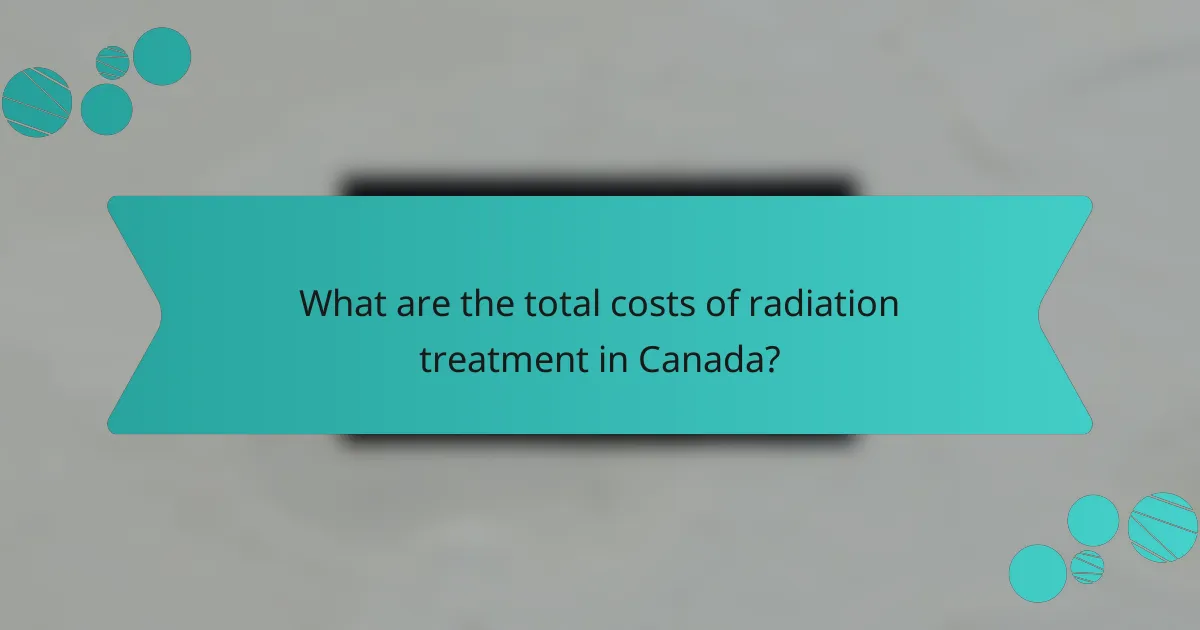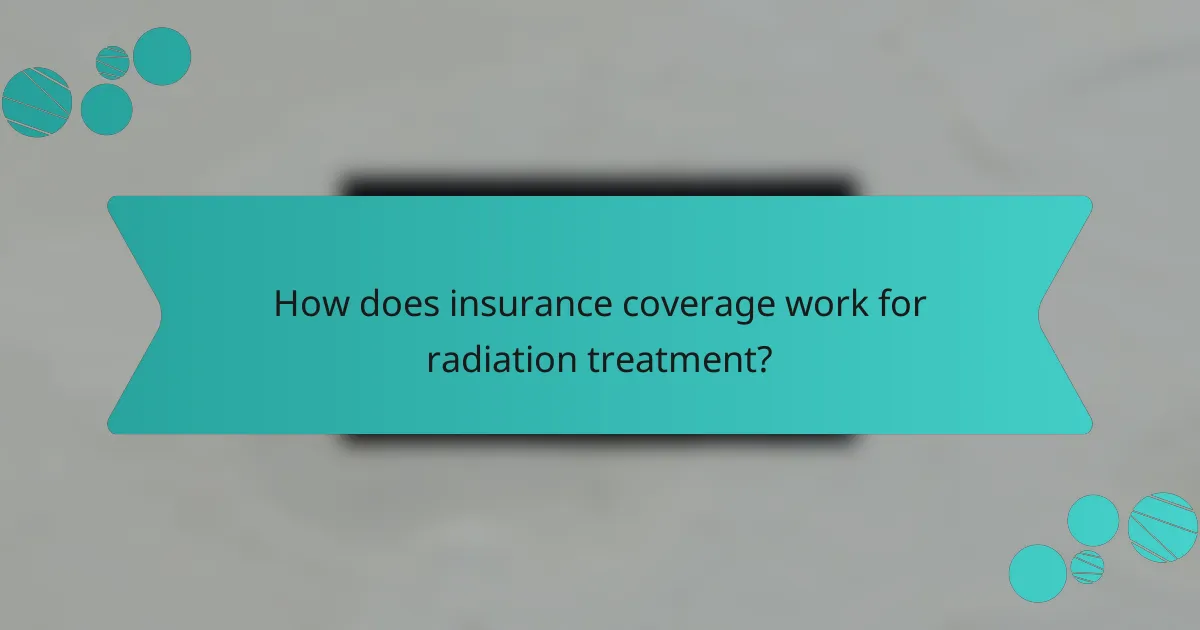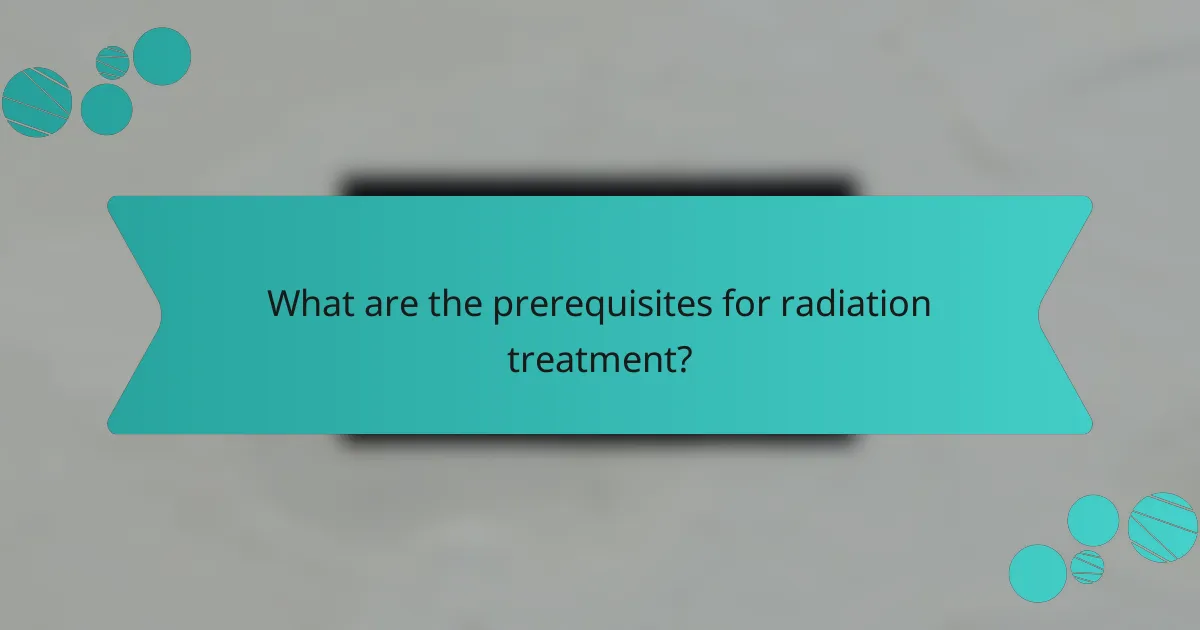Radiation treatment costs in Canada can range from a few thousand to tens of thousands of dollars, influenced by factors such as treatment type and location. Insurance coverage varies widely, affecting patients’ out-of-pocket expenses, so understanding individual policies is crucial. Additionally, financial assistance from government programs, non-profits, and charities can provide vital support to help manage these costs, ensuring that patients have access to necessary care.

What are the total costs of radiation treatment in Canada?
The total costs of radiation treatment in Canada can vary significantly based on several factors, including the type of treatment, duration, and location. Generally, patients can expect to pay anywhere from a few thousand to tens of thousands of Canadian dollars, depending on their specific circumstances.
Average treatment costs
On average, radiation treatment costs in Canada range from CAD 5,000 to CAD 30,000. This includes expenses for consultations, imaging, and the actual treatment sessions. The total cost may also encompass follow-up visits and any necessary supportive care.
Factors influencing costs
Several factors can influence the overall costs of radiation treatment, including the type of cancer being treated, the complexity of the treatment plan, and the technology used. For instance, advanced techniques like stereotactic radiosurgery may incur higher costs compared to standard radiation therapy.
Additionally, the duration of treatment and the number of sessions required can significantly impact the total expenses. Patients should also consider potential out-of-pocket costs for medications and additional therapies that may be necessary during treatment.
Cost variations by province
Costs for radiation treatment can vary by province due to differences in healthcare funding, availability of services, and local healthcare policies. For example, provinces like Ontario and British Columbia may have higher treatment costs compared to more rural provinces.
Patients should research their specific province’s healthcare system and inquire about any regional variations in costs. It’s also advisable to check if there are any provincial health programs that can help offset these expenses.

How does insurance coverage work for radiation treatment?
Insurance coverage for radiation treatment varies by policy and provider, impacting out-of-pocket costs for patients. Understanding how different insurance plans work can help patients navigate their financial responsibilities effectively.
Public insurance options in Canada
In Canada, provincial health plans typically cover radiation treatment as part of medically necessary services. Patients usually do not pay directly for these treatments, but may incur costs for related services such as transportation or medications.
Each province may have specific regulations and waiting times for treatment, so it’s essential to check with local health authorities for details. Coverage for additional therapies or services may vary, so reviewing your provincial plan is advisable.
Private insurance considerations
Private insurance can supplement public coverage by providing additional benefits for radiation treatment. Policies may cover costs for advanced technologies or treatments not included in public plans, as well as related expenses like travel or accommodation.
When choosing a private insurance plan, consider factors such as coverage limits, co-pays, and waiting periods. It’s beneficial to compare different plans to find one that aligns with your treatment needs and financial situation.
Common exclusions in coverage
Insurance plans often have exclusions that can affect coverage for radiation treatment. Common exclusions may include experimental treatments, certain types of imaging, or services provided by non-network providers.
Patients should carefully review their insurance policy to understand what is not covered. Consulting with an insurance representative can clarify any ambiguities and help avoid unexpected expenses during treatment.

What financial assistance is available for radiation treatment?
Financial assistance for radiation treatment can come from various sources, including government programs, non-profit organizations, and charity initiatives. These resources can help alleviate the costs associated with cancer care, making treatment more accessible for patients in need.
Government assistance programs
Government assistance programs often provide financial support for medical treatments, including radiation therapy. In the United States, programs like Medicaid and Medicare can cover a significant portion of treatment costs for eligible individuals. It’s essential to check the specific eligibility criteria and coverage details in your state, as these can vary widely.
In some countries, national health services may offer free or subsidized cancer treatments, including radiation. Patients should inquire about available options and how to apply for assistance through local health departments or cancer care centers.
Non-profit organizations offering support
Numerous non-profit organizations focus on providing financial aid to cancer patients undergoing treatment. These organizations may offer grants, low-interest loans, or direct financial assistance to help cover medical expenses. Examples include the American Cancer Society and CancerCare, which provide resources tailored to individual needs.
Patients should research non-profits that operate in their area, as many have specific eligibility requirements and application processes. Connecting with a social worker or patient navigator can also help identify suitable organizations and streamline the application process.
Charity programs for cancer patients
Charity programs specifically designed for cancer patients can offer vital financial support for radiation treatment. These programs may cover costs such as transportation, lodging, or even direct medical expenses. Organizations like the HealthWell Foundation and the Patient Advocate Foundation can assist patients in navigating these options.
When seeking charity assistance, it’s crucial to gather all necessary documentation, including medical records and financial statements, to expedite the application process. Patients should also be aware of deadlines and funding availability, as these programs often operate on a first-come, first-served basis.

What are the prerequisites for radiation treatment?
Before undergoing radiation treatment, patients must meet specific medical and procedural prerequisites. These typically include comprehensive medical evaluations and referrals from specialists to ensure the treatment is appropriate for their condition.
Medical evaluations required
Medical evaluations are crucial to determine the suitability of radiation treatment for a patient. These evaluations often include imaging tests, such as CT scans or MRIs, to assess the tumor’s size and location. Blood tests may also be conducted to check overall health and organ function.
Patients should expect to discuss their medical history and any previous treatments with their healthcare provider. This information helps in formulating a tailored treatment plan that considers potential risks and benefits.
Referral processes from specialists
Referral from a specialist, such as an oncologist, is typically necessary before starting radiation treatment. The oncologist will evaluate the patient’s condition and determine if radiation is the best option, often coordinating with other healthcare providers involved in the patient’s care.
Patients should ensure they have all necessary documentation and test results ready for their specialist appointments. This preparation can streamline the referral process and help in making timely decisions regarding treatment options.

How do costs compare between different types of radiation therapy?
The costs of radiation therapy can vary significantly based on the type used, with external beam radiation therapy generally being the most affordable option, while proton therapy tends to be the most expensive. Understanding these differences is crucial for patients when planning their treatment and managing expenses.
External beam radiation therapy costs
External beam radiation therapy (EBRT) is typically the least expensive form of radiation treatment, with costs ranging from several thousand to around ten thousand USD, depending on the treatment plan and the number of sessions required. This method uses high-energy beams directed at the tumor from outside the body.
Patients should consider factors such as the facility’s location, the complexity of the treatment, and whether additional imaging or planning is needed, as these can influence the overall cost. It’s advisable to consult with the treatment center for a detailed estimate based on individual circumstances.
Brachytherapy costs
Brachytherapy involves placing radioactive sources directly inside or near the tumor, which can lead to costs ranging from a few thousand to over twenty thousand USD. The price varies based on the type of brachytherapy used, such as low-dose rate (LDR) or high-dose rate (HDR), and the specific cancer being treated.
Patients should inquire about the facility’s experience with brachytherapy, as well as any additional costs for follow-up care or potential complications. Insurance coverage can also differ significantly for this treatment, so checking with providers is essential.
Proton therapy costs
Proton therapy is the most advanced and costly option, with treatment costs often exceeding thirty thousand USD. This technique uses protons instead of X-rays, allowing for more precise targeting of tumors while minimizing damage to surrounding healthy tissue.
Due to its higher cost, patients should investigate insurance coverage options thoroughly, as not all plans may cover proton therapy. Additionally, it is important to assess the potential benefits against the costs, particularly for specific types of cancer where proton therapy has shown significant advantages.

What are the emerging trends in radiation treatment financing?
Emerging trends in radiation treatment financing focus on innovative payment models and the integration of telehealth services, which aim to improve access and affordability for patients. These trends reflect a shift towards more patient-centered approaches in healthcare financing.
Innovative payment models
Innovative payment models, such as value-based care and bundled payments, are gaining traction in radiation treatment financing. These models emphasize patient outcomes rather than the volume of services provided, potentially lowering overall costs while improving care quality.
For example, bundled payments may cover all aspects of radiation treatment, including consultations, imaging, and follow-up care, for a single price. This approach can simplify billing and provide clearer cost expectations for patients, often resulting in savings compared to traditional fee-for-service models.
Telehealth and remote consultations
Telehealth and remote consultations are becoming increasingly important in radiation treatment financing, as they offer convenient access to specialists without the need for in-person visits. This can reduce travel costs and time, making treatment more accessible for patients in rural or underserved areas.
Many insurance plans now cover telehealth services, which can include virtual consultations with radiation oncologists. Patients should check with their insurance providers to understand coverage specifics, as policies can vary widely. Utilizing telehealth can also help streamline the treatment process, allowing for quicker decision-making and treatment initiation.
